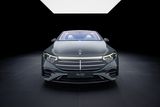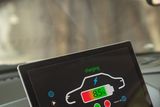More than skin deep ... G-whizz changes to new Mazda3 could turn you into a smoother driver
First drive in Aberdeen: Mazda 3
Back in the fifties and sixties, car manufacturers in America would launch new models on an annual basis.
More often than not, that update might be nothing more than an additional piece of chrome on the bumper or a reshaped wing, but it gave manufacturers a valuable marketing opportunity, with crowds flocking to dealerships in October to check out the new cars for the upcoming year.
One might be forgiven for thinking that Mazda is trying to revive this practice, as hot on the heels of the recently launched and mildly revised 2017 Mazda6, it has now revealed the 2017 version of the Mazda3 - with equally subtle updates.
You'd need to be a pretty hardcore enthusiast of the brand to spot the visual differences, even with the new hatchback and saloon sitting side by side against the outgoing versions.
Re-profiled bumpers and grille, LED lights, and an electronic rather than physical handbrake among other minor trim and detail updates hardly constitute branding the model as new.
However, under the skin there are some more interesting updates that make it worthwhile to take a fresh look at the Mazda3.
First up, and relevant in view of changing public opinions of the merits of petrol versus diesel, the 3 is now being offered in Ireland with an additional 2-litre 120PS SkyActiv-G petrol engine.
Available in the higher trim GT and Platinum specifications, it joins the existing 1.5 litre 100 PS petrol unit previously offered on entry level models.
Crucially, it can match that smaller unit's quoted fuel consumption of 5.1l/100km and CO2 emissions of 119g/km, figures that also stand up well against diesel counterparts.
The existing 1.5 litre 105PS and 2.2 litre 150PS oil burners complete the engine line-up.
The other significant development is the introduction of G-Vectoring Control.
Aimed at providing more precise handling, it works by varying engine torque to optimise the load on each wheel, thereby also giving a smoother ride - something passengers will no doubt appreciate.
It's a system that Mazda says will be of most benefit to motorists prone to harsh acceleration and braking by making them smoother drivers without even realising it.
On the safety front, an enhanced i-ACTIVSENSE system includes a new, forward sensing camera allowing the introduction of a new Traffic Sign Recognition (TSR) function among other features.
We put a selection of the latest models through their paces on a variety of roads around Aberdeen in Scotland.
First up, we'd say that the 2.0 petrol is definitely worthy of consideration. Normally aspirated it may be, but it feels as lively and torquey as the 1.5 diesel.
However, the 2.2 diesel would still be our pick of the bunch for what we can call optimal, stress-free motoring.
Quantifying the benefits of G-Vectoring Control directly isn't easy, but what we can say is the Mazda3 is a rewarding car to drive, tucking tenaciously into corners, and offering plenty of feedback about what's happening at the wheels, without compromising ride comfort.
It's in dealerships now and is priced from €23,295. That means you'll pay on average €300 more than the old versions cost.
That seems a reasonable hike for a car that's subtly improved all-round.
Join the Irish Independent WhatsApp channel
Stay up to date with all the latest news














